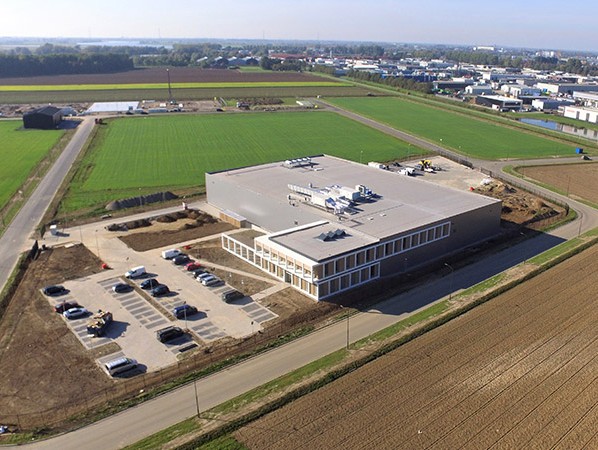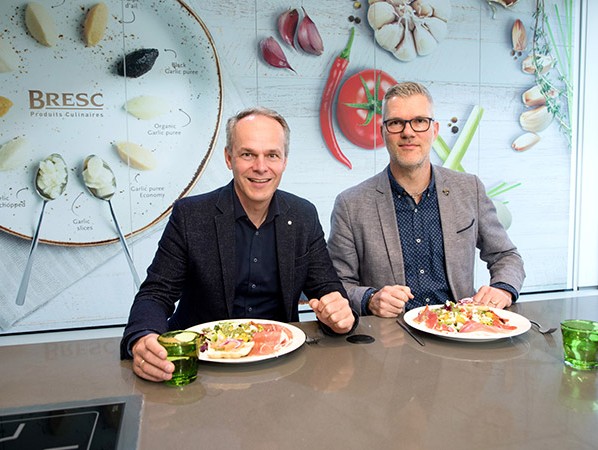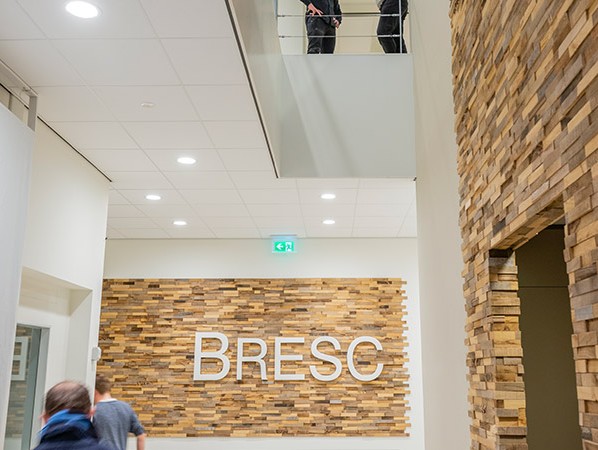
Bresc evolved from a local snail breeder into a garlic and herb specialist for the European gastronomy market. The continuous growth of the company demands choices in terms of raw materials, production, sustainability and accommodation. Bresc opted for new construction and entered into a dialogue with Aan de Stegge Twello.
In 1991, Jan Hak, Ruud Seltenrijch and Henk Brunt began breeding snails. Snails were bred outside Europe for this. Under the name BRunt ESCargots, they sold snails in jars to the higher-level hospitality industry. Herb butter was soon added to this. The entrepreneurs were not satisfied with the existing quality of the herbs and garlic and created their own mix that could be kept chilled fresh. The start of many more taste projects.
Today, Bresc no longer trades in snails and herb butter; it became a specialist in chilled fresh garlic and herbs for the gastronomy market. The attention of chefs grew thanks to the pure flavour and the consistent quality. The pioneers of the first hour saw that the company needed different management for further growth and they involved external board members. Arjan Hak joined as Managing Director in 2012: “I am an analyst and determine where we are and can be successful. We grow by 10% annually. I look forward and adjust our strategy accordingly”.
“We are seasoners and inspire the chefs”, says Arjan with a sparkle in his eyes. “But this beauty was not reflected by our accommodation at three different locations. We started talking to architectural firms and construction companies and asked a graduate to investigate: ‘should we move to an existing building or opt for new construction?’. Converting an existing building was shown to be impractical due to the requirements of our production areas, so new construction it was. I immediately asked our shareholders for commitment. At that time, they wanted to sell their shares and we had to postpone our construction plans. We found a new parent in Hügli, who gave us permission for the new construction project in 2016.”

Bas te Riele (left) en Arjan Hak
Bresc chose to collaborate with engineering firm Uticon and construction company Aan de Stegge Twello. The personal contact was the deciding factor. Arjan: “Aan de Stegge’s approach was in line with ours: scope, time and money”. Bas te Riele, commercial project leader at Aan de Stegge, confirms Arjan’s statement: “We are positively stubborn, take the client with us, work together and communicate openly and transparently”.
Prior to construction, the space layout and cost estimate were determined with Uticon. During the engineering phase, Bresc and Aan de Stegge reviewed the plan every two weeks in order to make adjustments in terms of content, quality, size and money. They made choices that emphasised food-safe buildings, the right routing in relation to hygiene, installations, investment value of the building and sustainability.
“Sustainability is an important theme”, Arjan explains, “sometimes also conflicting. For instance, we use energy for the required conditioning of production areas, but we no longer need a truck to transport things back and forth between three locations. There is now also a loading pit with 3 docks, where the truck can connect to a sluice in order to preserve the coolness in the shipping area. We use LED lighting, heating through the re-use of residual heat from the compressor, and prevent contamination risks through the construction of the sewer, whereby wastewater flows from the cleanest to the most contaminated area. In 2020, solar cells on the roof will follow. For our people, we have standing/sitting desks and plants for filtering particulate matter and noise reduction”.
Aan de Stegge started in late January and delivered in September 2018, according to plan. “We did not encounter any major surprised”, says Arjan. “However, at the request of our parent company, based on food defence, a 2.5-metre-high fence was added around our building.” Bas adds: “We live up to our agreements and have lots of experience in engineering and building for the food industry. An inventory of the wishes and requirements determines the course of the construction here. By asking the right questions in advance, you avoid all sorts of undesired changes and additional work during construction. For upcoming food projects, we have already drawn up a new Plan of Action template, an extensive checklist in preparation (see box, ed.)”.

The process was challenging and inspiring for the parties involved. Bas looks back: “It was a great time of collaboration, looking ahead and doing business. Construction is a party”. Arjan, full of pride: “And we celebrated that party! The first pole, a ‘wind-and-watertight-party’, a construction site tour and the official opening on December 15”.
In 2018, Hügli was acquired by Bell Food Group. The management, upon a visit to the new construction, advised purchasing the vacant piece of land (3.4 hectares) next to the building. Arjan: “We constructed and relocated in 2018. We are investing in new machines in 2019 and 2020. We want to double our production five years from now, so it is time to scale up. I am already looking forward to the expansion”.
Plan of Action
Entrepreneurs with construction plans tend to be ‘at their wit’s end’. Bas te Riele: “There are so many questions. Where and with whom do I start? How do I approach the process? How large will the building be, what will it cost me? The entrepreneur generally starts by estimating the desired surface area, height and depth of the areas. Drawings soon follow; by us, a drawing office or an architect. That is workable, but not very efficient. Because from the first design, a new design follows. And another, and another... Some matters are initially overlooked, or there are wishes that do not come to the fore until a later phase. As a result, the routing and zoning are no longer correct. The costs rise.”
A good start is half the battle, according to Aan de Stegge Twello. “First consider what you truly want. Where do you currently stand? What do you want to achieve in the future? In order to map this properly, we have been working on a questionnaire in the past year: a ‘Programme of Requirements’ or PoR. Filling it out costs time; the entrepreneur and their colleagues are challenged to think about many different things, but it avoids running into surprises later. We, or a hired architect, realise the first design based on the PoR. Such a so-called ‘stain plan’ has appeared to hit the mark in the past more than once. And because the PoR provides a good picture of all wishes and requirements, we can map the expected foundation costs much better. That, too, provides clarity.”
Images: ©HERBERT WIGGERMAN
Source: © Vakblad Voedingsindustrie 2019